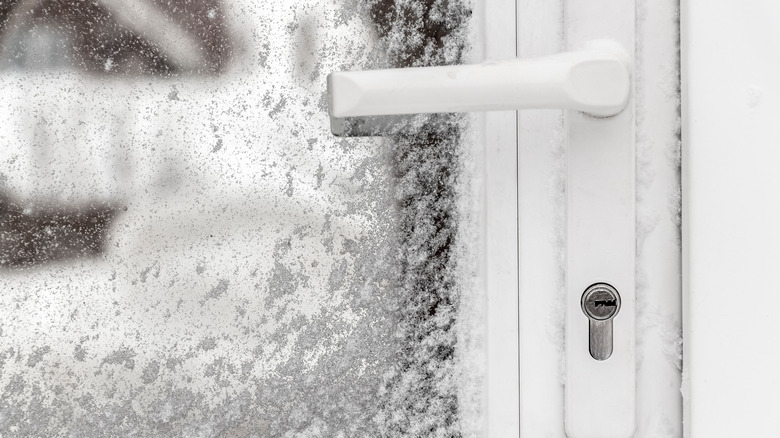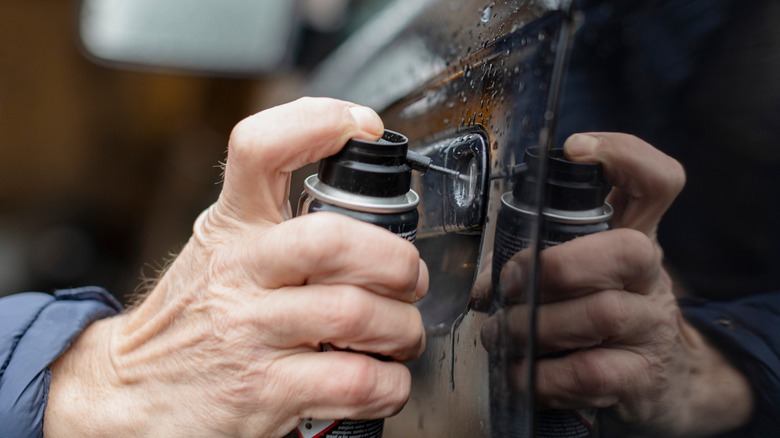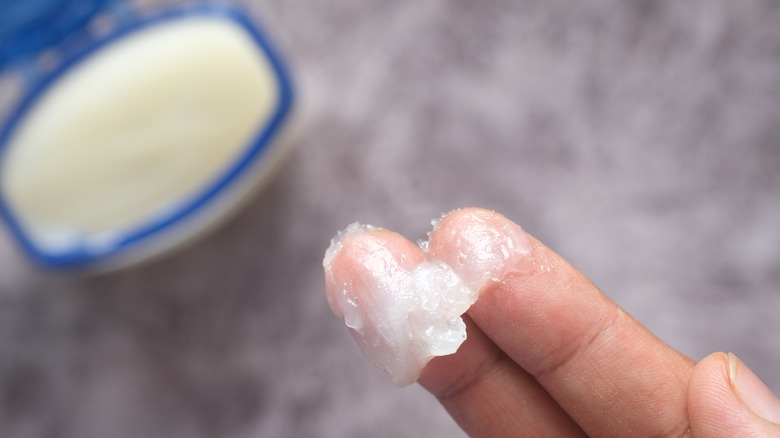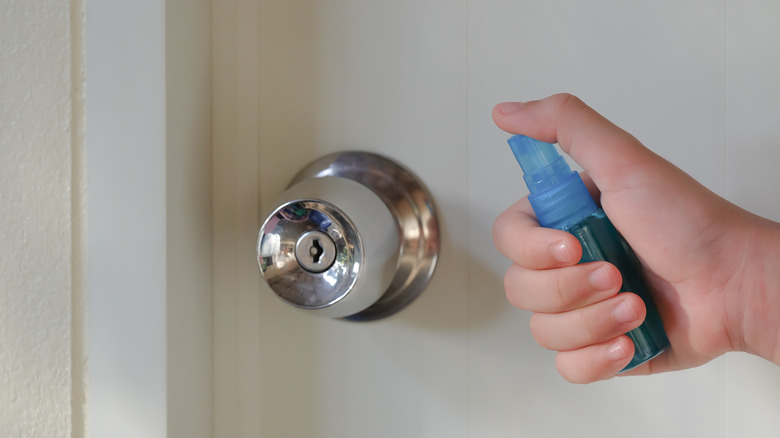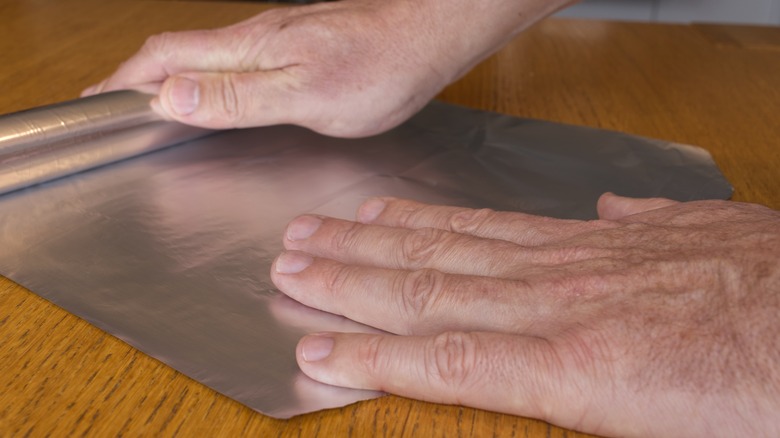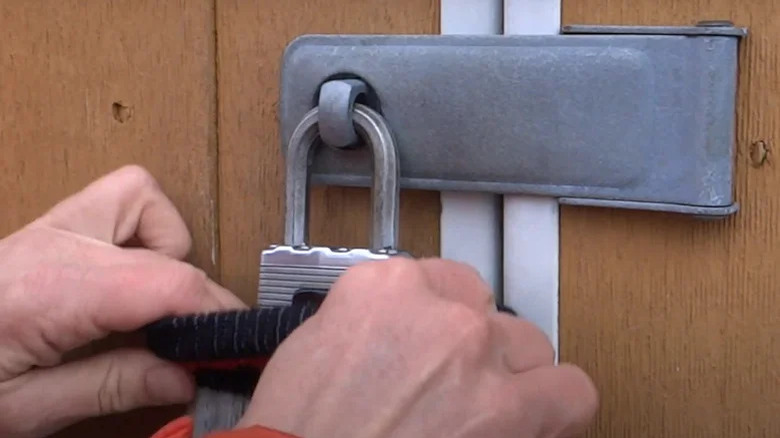Hacks To Prevent Your Outdoor Locks From Freezing
Locks are an everyday security staple, yet they can also turn into our adversaries when the thermometer plunges below freezing. The frustration is all too real: Your key won't budge, and the once-reliable lock is now just a solid, icy barrier. It's not just annoying; it's a potential safety risk, too. If your lock freezes, it could prevent you from accessing something essential or, worse, lock you out with no way of getting in until the lock thaws.
To avoid this predicament, here are trusted hacks that will prevent this annoyance from ever happening. Using items readily found in your home or at any hardware store, you can easily protect your lock from harsh temperatures. These hacks either focus on protecting the internal workings of the lock or taking external measures to keep the elements from taking over the mechanism. Or, for extra protection, you can use a combination of both. The winter weather is hard enough, so to make those chilly days a little easier, here are some ways to prevent your locks from freezing.
Lubricate your locks
Lubricating your locks is an essential part of lock maintenance any time of year, but getting them in good shape prior to the start of winter will save you the hassle of having to fight a frozen door. Lubricating them is crucial to prevent freezing, as it helps displace moisture that could eventually form into ice. Lubricants can also help prevent rust and corrosion, which can cause the lock to become stuck and difficult to operate.
Your first thought might be to grab a trusty can of WD-40, but this would be a mistake. The product will leave an oily residue behind that could attract dust and make it stick. Instead, use a dry lubricant like Teflon lubricant or graphite powder. It can withstand extreme temperatures and harsh environments, and it often lasts longer than its wet counterparts, reducing the need for frequent re-application. Simply apply these lubricants into the lock according to the directions on the packaging, and your winter will become instantly easier.
Cover lock openings with a magnet
One great way to keep your locks from freezing is to block moisture from entering their openings in the first place. Since they are made from metal, the easiest and most affordable solution is to use small magnets to cover their openings. The magnets will shield the locks from rain, snow, or other forms of moisture, which can cause them to freeze. They also act as an insulating layer, reducing the lock's exposure to the cold air and preventing it from reaching the freezing point.
To keep your lock warm and dry, buy a magnet that is roughly the same size as the opening. For example, these Master Magnet discs from Home Depot measure just under half an inch, making them the perfect size for many home locks. It's also important to choose a magnet that is strong enough since you want it to securely stick to the lock even in high winds or intense rain. You can simply remove the magnet when you need to unlock the door, and then slide it back into place once done.
Cover the lock with petroleum jelly
If you want to use the items you have at home — or if you are in a pinch with a sudden cold snap approaching — you can use petroleum jelly to prevent freezing. It creates a barrier that prevents moisture from reaching the internal components of the lock. This moisture could otherwise freeze, causing it to become stuck or jammed. Just make sure that the lock is completely dry before doing this, or else you will be trapping water inside, defeating the purpose of the hack.
To do this hack, dip your key into some petroleum jelly and put it into the lock. Wiggle it around as much as you can, then open and close the lock a few times to make sure that it has spread as thoroughly and evenly as it can. You should do this every week or so to make sure that the layer is sufficient enough to be effective. While this hack does work, it's worth noting that petroleum jelly can attract dirt and dust, which may need to be cleaned periodically. If you don't clean it out, there could be build-up over time, which would impair its function. This makes it a good solution for people in areas where freezing temperatures are uncommon, since you can do this hack quickly and use what you have on hand. However, if you are routinely facing harsh weather, you may want to find a more permanent solution.
Apply a homemade de-icer
If you have a bottle of rubbing alcohol in your cabinet, this versatile ingredient can be used to create a homemade de-icing solution. This works because alcohol has a lower freezing point than water. It freezes at -174.6 degrees Fahrenheit, while water ices over at 32 degrees Fahrenheit. When you apply the alcohol-based de-icer to a lock, it mixes with the water and lowers the overall freezing point, making it more difficult for the water to freeze. This process is called freezing point depression, the same process behind the use of road salts and automobile antifreeze.
To do this hack, simply take an empty spray bottle and combine 2 parts rubbing alcohol with 1 part water. Combine the two ingredients and spray the mixture into the lock. This will help prevent the lock from freezing, but you can also keep the rest of the solution on hand as a de-icer to combat any ice that may form. It is important to remember that rubbing alcohol comes in different strengths, and this solution will be the most effective if you use one with 70% or 90% strength as opposed to 50%.
Apply hand sanitizer in a pinch
Using hand sanitizer to prevent freezing locks is a handy hack for those living in cold climates, especially if you find yourself caught in an unexpected storm since hand sanitizer is something you might already have in your bag. Because most hand sanitizers have either ethanol (ethyl alcohol) or isopropyl alcohol as their active ingredient, applying them to a lock prevents it from freeing for the same reason as the de-icer method. When you put hand sanitizer into a lock, the alcohol in it lowers the threshold for how cold it needs to get in order to freeze.
Simply squeeze some hand sanitizer onto the key and insert it into the lock. Turn the key back and forth several times to make sure it is as well dispersed as possible. Allow it to sit for a minute, giving the freezing point enough time to lower. This works to both prevent freezing and helps to thaw a frozen lock. This method can be a lifesaver in a pinch, but remember, it might not be as effective as commercial de-icers in extreme conditions.
Cover with thermal insulating tape
Keeping the inside of a lock dry is the best way to make sure it doesn't freeze, and using tape to cover its opening is a handy method. For this hack, there are two types of tape you could use: duct tape or thermal insulating tape. Thermal insulating tape is designed to withstand a wide range of temperatures and weather conditions, making it suitable for use in outdoor and extreme-temperature applications. Usually made from fiberglass, you can use it to wrap furnace seals or pipes that are in danger of freezing. Because of this, you can use a small piece to prevent your locks from freezing, but if you don't have a roll handy, you can also try using duct tape.
To use this hack, either grab your roll of duct tape or buy a roll of insulating tape like this Nashua brand tape from Home Depot, which can withstand temperatures from -25°F to 260°F. Cut a piece long enough to cover the keyhole and lock face. You can add a few layers to make sure it seels the lock sufficiently. When the cold weather passes, simply peel off the tape and clean any residue. This hack works best for a short-term solution or on locks that aren't opened frequently. That's because the tape will lose its adhesive quality every time you remove it to open the lock.
Cover it with aluminum foil
Aluminum foil is an amazing insulator because it bounces heat back to where it's coming from. So rather than heat passing through it, it instead reflects it back to the original heat source. Because of this, you can use regular household aluminum foil to insulate your lock and prevent the cold and moisture from getting in. This will keep it from icing over.
Grab your roll of aluminum foil and cut a piece that is large enough to wrap around the lock. Make sure to wrap it as tightly as you can so that there are no big gaps that water would seep into. Secure the foil either with a piece of tape or by folding it to make sure it doesn't blow off. Because this hack protects the lock externally, you could also pair it with a method of protecting the lock internally. For example, you can spray it with graphite powder before you cover it with aluminum foil, making the lock as secure against the elements as it can be.
Wrap a sock around the lock
Repurposing lone socks as insulation is a cost-effective solution that utilizes items you might already have lying around. It is the perfect use for any spare socks you have in your drawer. Much like the aluminum foil method, this will help prevent moisture and cold from getting inside the lock and freezing. However, this hack only works for things like padlocks since it requires the sock to be able to wrap around the lock, something that isn't possible with things like a front door or a deadbolt lock.
You will want to use the thickest sock possible since the thicker the sock, the more insulation. But beware, this hack only works if you are dealing with cold temperatures that also aren't wet. If the sock gets moist, it will freeze and be difficult to remove from the lock. This also might not be effective if the temperatures dip into the single digits or below zero. At that point, you may want to use a more commercial hack, such as using graphite powder to prevent moisture accumulation or de-icing spray to thaw out an already frozen lock.
